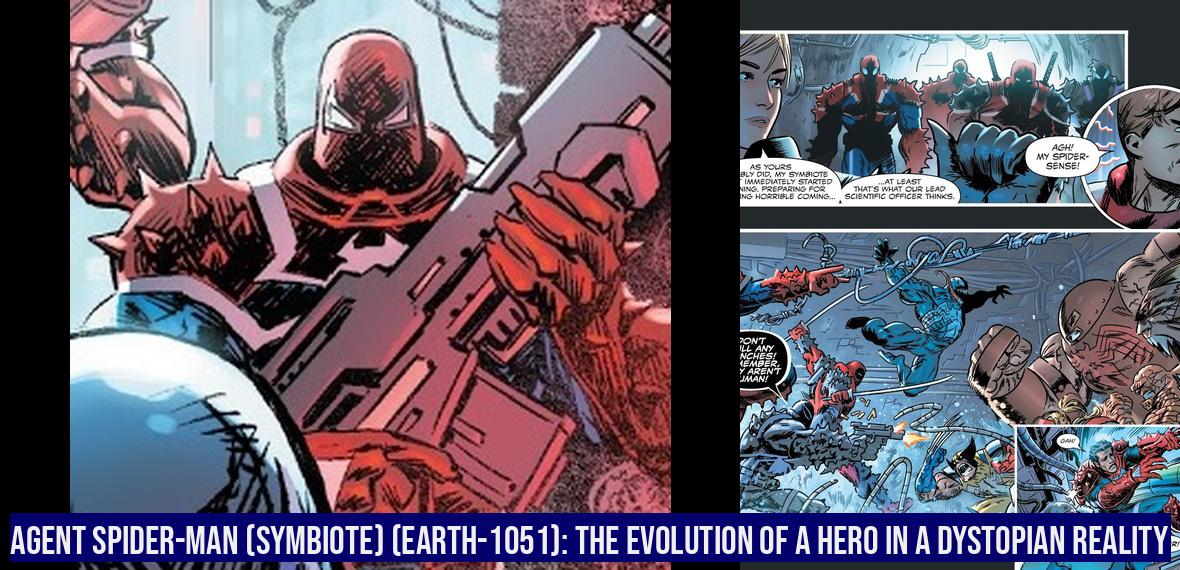Agent Spider-Man (Symbiote) (Earth-1051): The Resilience of a Hero
In the vast tapestry of the Marvel Multiverse, many characters inspire awe through their unique stories and transformations. One such character, Agent Spider-Man (Symbiote) from Earth-1051, emerges as a compelling figure navigating a dystopian landscape while donning the iconic and complex mantle of Spider-Man. As a fusion between Peter Parker and a symbiotic suit, this iteration of Spider-Man encapsulates a narrative of struggle, loss, and ultimately, resilience in a world teetering on the brink of collapse.
History: The Transformation of Peter Parker
The story of Agent Spider-Man begins in the midst of the catastrophic Sym-Soldier Program, initiated to counter the insidious reach of Codex Hive. This dark and brooding force had turned the once-vibrant Earth into a battlefield, wherein many of the planet’s heroes and villains met their tragic fates. Under this desperate circumstance, Peter Parker was bonded with a symbiote, transforming him into Agent Spider-Man. Together, they aimed to combat Codex, an entity that sought to expand his dominion by converting the entire population into mindless symbiote-aggregates under his control.
As the war raged on, Peter and his fellow symbiote-soldiers were forced to retreat into the shadows, finding shelter in the desolate remnants of S.H.I.E.L.D. tunnels buried beneath Manhattan. This grim backdrop not only emphasized the stakes of the conflict but also honed the resolve of its heroes. In a fortuitous twist, the remaining resistance allies crossed paths with Earth-616’s Venom and his son, Dylan Brock. Together, they orchestrated a pivotal counter-offensive against Codex that would alter the tide of the battle.
The Turning Point: Allies from Another Universe
One of the most thrilling aspects of the Agent Spider-Man’s saga is the collaboration with characters from alternate realities. Dylan Brock emerged as a beacon of hope, providing the necessary means to sever Codex’s connection to Knull, the Dark God who empowered him. This dramatic act culminated in the demise of Codex’s horrendous symbiotic horde, restoring a semblance of peace to a world ravaged by unfettered chaos. However, the lingering effects of the Sym-Soldier Program were an indelible mark on the universe, leaving the symbiote-soldiers fundamentally altered albeit intact.
Attributes: The Duality of Power
Agent Spider-Man embodies a unique amalgamation of Peter Parker’s strength and the formidable powers granted by his symbiote. This distinctive character draws on agility, enhanced strength, and web-slinging abilities characteristic of Spider-Man, while gaining additional combat prowess from the symbiotic bonding. This duality not only shapes his identity but also presents a blend of heroic and anti-heroic traits that create compelling narrative tension. The breadth of abilities afforded by the symbiote—stealth, regenerative capabilities, and the capacity to manipulate webbing—marks him as a formidable opponent against various threats.
Abilities: A Hero Reimagined
While Agent Spider-Man retains the iconic abilities of Spider-Man, the symbiote enriches these attributes, allowing for greater adaptability in combat and strategy. With the power to cloak himself and manipulate his surroundings, Agent Spider-Man can approach battles with an unprecedented edge. Additionally, the symbiote’s regenerative capabilities enable him to recover from injuries and fatigue more rapidly than his Earth-616 counterpart, making him a nearly unstoppable force. This heightened resilience speaks volumes about the narrative potential within stories involving complex identities and shifting allegiances in times of war.
Conclusion: A Multifaceted Character in the Marvel Multiverse
As we explore the universe of Agent Spider-Man (Symbiote) (Earth-1051), it becomes evident that this iteration is more than just a chapter in the Spider-Man lore. He is a manifestation of human resilience against overwhelming odds, a reflection of the struggles faced when one’s reality is shattered by malevolent forces. The tales of Agent Spider-Man remind us that even at our darkest hours, hope perseveres, and alliances forged through shared trials can illuminate even the bleakest paths.
See Also
- Agent Spider-Man (Symbiote) (Earth-1051) Insights
- Codex: The Dark Antagonist
- Venom: The Hero and Anti-Hero
Ultimately, Agent Spider-Man emerges not just as a legacy of Peter Parker’s heroism but as a vital part of the larger Marvel narrative. With his remarkable journey across Earth-1051, he exemplifies the essence of superhero storytelling: courage in the face of despair and the enduring bond between heroes, even across multiversal boundaries.
What is the origin of Agent Spider-Man (Symbiote) from Earth-1051?
Agent Spider-Man (Symbiote) originates from the catastrophic Sym-Soldier Program, which was initiated to combat the threat posed by Codex Hive. In this dire situation, Peter Parker bonded with a symbiote, transforming him into Agent Spider-Man to fight against Codex and his plans to control the population.
How does Agent Spider-Man collaborate with characters from other universes?
Agent Spider-Man collaborates with characters from alternate realities, notably teaming up with Earth-616’s Venom and his son, Dylan Brock. This alliance plays a crucial role in orchestrating a counter-offensive against Codex, ultimately leading to the defeat of Codex’s symbiotic horde.
What unique abilities does Agent Spider-Man possess?
Agent Spider-Man possesses a unique combination of Peter Parker’s traditional Spider-Man abilities, such as agility, enhanced strength, and web-slinging, along with additional combat prowess granted by the symbiotic suit. This blend of powers creates a character with both heroic and anti-heroic traits.
What impact did the Sym-Soldier Program have on the universe?
The Sym-Soldier Program left a lasting impact on the universe, fundamentally altering the symbiote-soldiers involved. While they remained intact, the experiences and struggles they faced during the program marked them indelibly, shaping their identities and narratives in the aftermath of the conflict.

